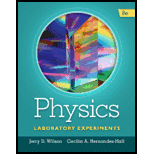
Concept explainers
Scientists use models and theories to describe physical phenomena. When a new model is developed, it must be tested to find out if it is an accurate representation. No theory or model of nature is valid unless its predictions are in agreement with experimental results. The laboratory provides an environment where extraneous factors can be minimized and specific predictions can be tested. The process of making, testing, and refining models is usually called the scientific method (see Experiment 1).
An example of this method will be demonstrated in this experiment for a simple pendulum. A “simple” pendulum is one in which a small but substantial mass is suspended on a relatively light string, like the one pictured in Fig. 4.1. If one were to observe the motion of the mass swinging back and forth, which of the following statements do you think would be the most accurate? (It is understood that the motion takes place in a single plane.)
The time for the mass to swing back and forth (from point A to B, and back to A in Fig. 4.1.)
- (a) changes randomly from one swing to the next.
- (b) gets consistently bigger from one swing to the next.
- (c) gets consistently smaller from one swing to the next.
- (d) stays about the same from one swing to the next.
(Circle your choice)
The most accurate statement regarding the motion of a simple pendulum.
Answer to Problem 1EP
Option (d) The time for the mass to swing back and forth stays about the same from one swing to the next.
Explanation of Solution
The time for the mass of the simple pendulum to swing back and forth is termed as the period of oscillation. The period of oscillation of the pendulum depends only on the length of the pendulum and it can be obtained from the relation,
Here,
For a pendulum of fixed length, the period of oscillation remains the same for all oscillations, unless the pendulum is subjected to considerable friction or air resistance.
Conclusion:
Since the time for the mass of the pendulum to swing back and forth stays about the same from one swing to the next, option (d) is correct.
The period of the simple pendulum does not change randomly from one swing to the next. Thus, option (a) is incorrect.
The period of the simple pendulum does not get consistently bigger from one swing to the next. Thus, option (b) is incorrect.
The period of the simple pendulum does not get consistently smaller from one swing to the next. Thus, option (c) is incorrect.
Want to see more full solutions like this?
Chapter 4 Solutions
Physics Laboratory Experiments
- One student uses a meterstick to measure the thickness of a textbook and obtains 4.3 cm 0.1 cm. Other students measure the thickness with vernier calipers and obtain four different measurements: (a) 4.32 cm 0.01 cm. (b) 4.31 cm 0.01 cm, (c) 4.24 cm 0.01 cm, and (d) 4.43 cm 0.01 cm. Which of these four measurements, if any, agree with that obtained by the first student?arrow_forwardA sidewalk is to be constructed around a swimming pool that measures (10.0 0.1) m by (17.0 0.1) m. If the sidewalk is to measure (1.00 0.01) m wide by (9.0 0.1) cm thick, what volume of concrete is needed and what is the approximate uncertainty of this volume?arrow_forwardState how many significant figures are proper in the results of the following calculations: (a) (106.7)(98.2)/(46.210)(1.01) (b) (18.7)2 (c) (1.601019)(3712)arrow_forward
- The Scope and Scale of Physics Find the order of magnitude of the following physical quantities. (a) The mass of Earth’s atmosphere: 5.11018kg : (b) The mass of the Moon’s atmosphere: 25,000kg ; (c) The mass of Earth’s hydrosphere: 1.41021kg : (d) The mass of Earth: 5.971024kg : (e) The mass of the Moon: 7.341022kg : (f) The Earth-Moon distance (semimajor axis): 3.84108m : (g) The mean Earth-Sun distance: 1.51011m : (h) The equatorial radius of Earth: 6.38106m : (i) The mass of an electron: 9.111031kg : (j) The mass of a proton: 1.671027kg : (k) The mass of the Sun: 1.991030kg .arrow_forwardWrite the following quantities in standard units. (a) 0.55 Ms (b) 2.8 km (c) 12 mg (d) 100 cmarrow_forwardCalculate the result for each of the following cases using the correct number of significant figures. a. 3.07670 10.988 b. 1.0093 105 9.98 104 c. 5.44231064.008103arrow_forward
- Use the rules for significant figures to find the answer to the addition problem 21.4 + 15 + 17.17 + 4.003. (See Section 1.4).arrow_forwardFor a given speed limit, would the numerical value be greater in mi/h or in km/h?arrow_forwardA house is advertised as having 1 420 square feet under its roof. What is area in square meters? (a) 4 660 m2(b) 132 m2 (c) 158m2 (d) 132 m2 (e) 10.2m1arrow_forward
 University Physics Volume 1PhysicsISBN:9781938168277Author:William Moebs, Samuel J. Ling, Jeff SannyPublisher:OpenStax - Rice University
University Physics Volume 1PhysicsISBN:9781938168277Author:William Moebs, Samuel J. Ling, Jeff SannyPublisher:OpenStax - Rice University Principles of Physics: A Calculus-Based TextPhysicsISBN:9781133104261Author:Raymond A. Serway, John W. JewettPublisher:Cengage Learning
Principles of Physics: A Calculus-Based TextPhysicsISBN:9781133104261Author:Raymond A. Serway, John W. JewettPublisher:Cengage Learning An Introduction to Physical SciencePhysicsISBN:9781305079137Author:James Shipman, Jerry D. Wilson, Charles A. Higgins, Omar TorresPublisher:Cengage Learning
An Introduction to Physical SciencePhysicsISBN:9781305079137Author:James Shipman, Jerry D. Wilson, Charles A. Higgins, Omar TorresPublisher:Cengage Learning Physics for Scientists and Engineers with Modern ...PhysicsISBN:9781337553292Author:Raymond A. Serway, John W. JewettPublisher:Cengage Learning
Physics for Scientists and Engineers with Modern ...PhysicsISBN:9781337553292Author:Raymond A. Serway, John W. JewettPublisher:Cengage Learning Physics for Scientists and EngineersPhysicsISBN:9781337553278Author:Raymond A. Serway, John W. JewettPublisher:Cengage Learning
Physics for Scientists and EngineersPhysicsISBN:9781337553278Author:Raymond A. Serway, John W. JewettPublisher:Cengage Learning Physics for Scientists and Engineers: Foundations...PhysicsISBN:9781133939146Author:Katz, Debora M.Publisher:Cengage Learning
Physics for Scientists and Engineers: Foundations...PhysicsISBN:9781133939146Author:Katz, Debora M.Publisher:Cengage Learning





